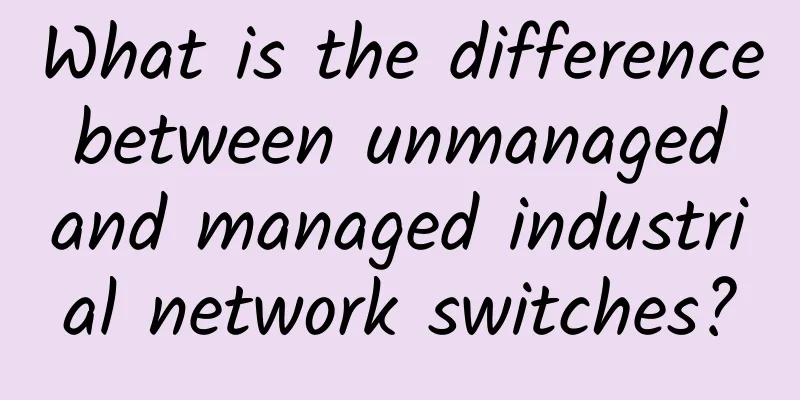What is the difference between unmanaged and managed industrial network switches?

|
There are two basic types of industrial network switches: managed and unmanaged. Managed switches offer centralized management and more control over traffic, while unmanaged switches are ideal for small and startup businesses that don't need a large number of ports. While unmanaged switches may be cheaper initially, they can result in a loss of network control when problems arise. Managed switches offer similar functionality to unmanaged switches, but they include more advanced management and troubleshooting features. They typically use SNMP (Simple Network Management Protocol) to relay configuration data to network engineers. This makes troubleshooting easier and improves uptime. Managed switches offer more flexibility. They support more features and are more secure. However, unmanaged switches tend to be cheaper and require no setup. Unmanaged switches are often used to connect temporary groups of devices or to connect devices to a larger network. For example, a surveillance camera sends data to an unmanaged switch, which then sends it to a managed switch. Managed industrial network switches offer more advanced features than unmanaged industrial network switches. For example, managed switches can monitor traffic and provide alerts for power redundancy failures. In addition, managed switches are more expensive than unmanaged switches. They can also provide greater network awareness and custom communication parameters. A managed industrial switch is an essential component of any smart manufacturing system. It allows the network to work in harsh environments. It also reduces the possibility of single points of failure. Managed industrial switches are designed to withstand extreme temperatures and are resistant to noise and vibration. Industrial Ethernet switches can also provide administrators with greater access control. Managed industrial network switches are more expensive than unmanaged switches. However, their features make them a smarter choice for many industrial applications. Managed switches may also offer more features and support. Managed switches can also be more powerful, but they require more maintenance. Managed switches offer better control and management, while unmanaged switches are easier to use and have more flexibility. Unmanaged switches are generally the most economical and best used for simple applications with only a few ports. However, if you need more than 3 Ethernet switches, you should consider purchasing managed switches. Managed switches allow you to monitor traffic on the switch and automatically divert it to other ports if the data connection is interrupted. This allows you to analyze traffic on the network without interrupting production. Managed switches can also help you remotely manage the network, reducing the need for on-site network administrators to monitor the system. Unmanaged switches do not have a web interface and cannot be managed remotely. They are often used in small networks to connect edge devices. They can also be used to add temporary groups of devices to a larger network. Some surveillance cameras use unmanaged switches to transmit data to managed switches. How should I choose between managed and unmanaged switches? Unmanaged switches are more cost-effective than managed switches and are usually the best choice for smaller networks. However, if you have a lot of data to move, you may want to opt for a managed switch. This type of switch offers more options and allows you to customize its settings. Managed switches also offer better speed and scalability. On the other hand, unmanaged switches are more convenient for plug-and-play operation. Managed switches can also be used to prioritize certain channels in a LAN and create VLANs (Virtual Local Area Networks). VLANs can isolate traffic from different users and prevent network failures. Managed switches are ideal for enterprise businesses, but they also require professional configuration and maintenance. Managed switches offer better security. They allow the creation of VLANs (Virtual Local Area Networks). This allows you to segment network traffic and devices based on criteria other than geographic location. For example, marketing employees in an office building can share resources without being visible to the rest of the department. This avoids unnecessary traffic and improves system performance. In addition, it adds an extra layer of security. Managed switches are usually a better choice for networks with large data centers. However, they can also be used for smaller networks and home networks. In addition to allowing you to configure each port, managed switches can also monitor and troubleshoot their performance remotely. Managed switches can be accessed remotely through a web interface or command line. A managed switch allows users to customize the switch's settings and network configuration. In addition, it allows you to add temporary systems to the network, which is not possible with an unmanaged switch. In addition, a managed switch can help you recover important data when a network failure occurs. |
<<: How mature is 5G private network?
>>: How will AI and 5G drive the next wave of innovation?
Recommend
Why is it that few people are using 5G after two years of commercial use? In addition to signal problems, there are three other reasons
In 2019, my country built more than 130,000 5G ba...
Which open source API gateway is better?
[[412862]] Image from Baotu.com Today I will disc...
Breaking news: China Unicom announced that it will shut down its 2G network. After 17 years, 2G has successfully retired!
Not long ago, there was news that China Unicom wa...
UK: Infrastructure cannot keep up, 5G application progress is slow
According to reports, 5G deployment in the UK is ...
5G network is accelerating! More than 500,000 5G base stations have been built and put into operation across the country
Since the 13th Five-Year Plan, my country has vig...
5G is more complex than you think
In the future, 5G networks are developing in the ...
The impact of next-generation communication protocols on smart building technology
The emergence of next-generation communication pr...
What is Wi-Fi 7?
The Wireless Broadband Alliance (WBA) announced i...
What is 6G and when can we expect it?
Since 5G networks are still being deployed around...
DogYun May Day discount: 100 yuan/month discount for independent servers, 30% discount for dynamic cloud, 20% discount for classic cloud, top up 100 yuan and get 10 yuan free
DogYun has launched a promotion during the May Da...
[Black Friday] AlphaVPS: AMD Ryzen KVM/Large Hard Drive KVM, starting at 15 Euros per year, Los Angeles/Bulgaria Data Center
AlphaVPS's Black Friday special packages incl...
Summary information: Yunmi Technology/Yunji Internet/Duoxiantong/PigYun/Cool Cloud
The traditional Chinese New Year is approaching, ...
Overview of important developments in the global 5G field in November 2020
In 2020, China, which was the first to achieve a ...
Share an interesting data analysis method
[[405125]] This film note is a development summar...
Will 5G become a new springboard for domestic cloud computing giants to surpass international giants?
As an important member of the new infrastructure ...









